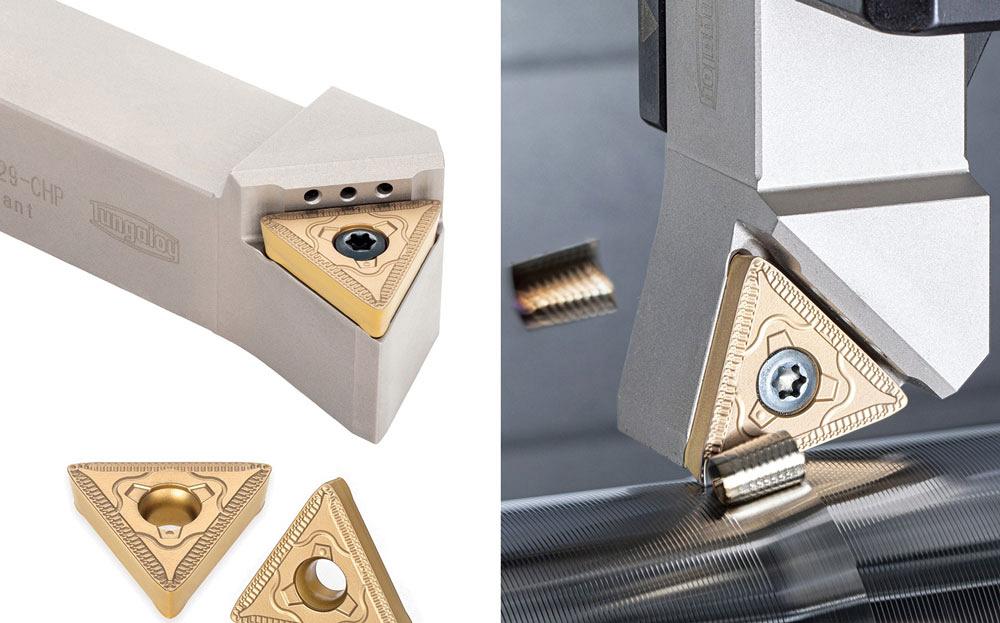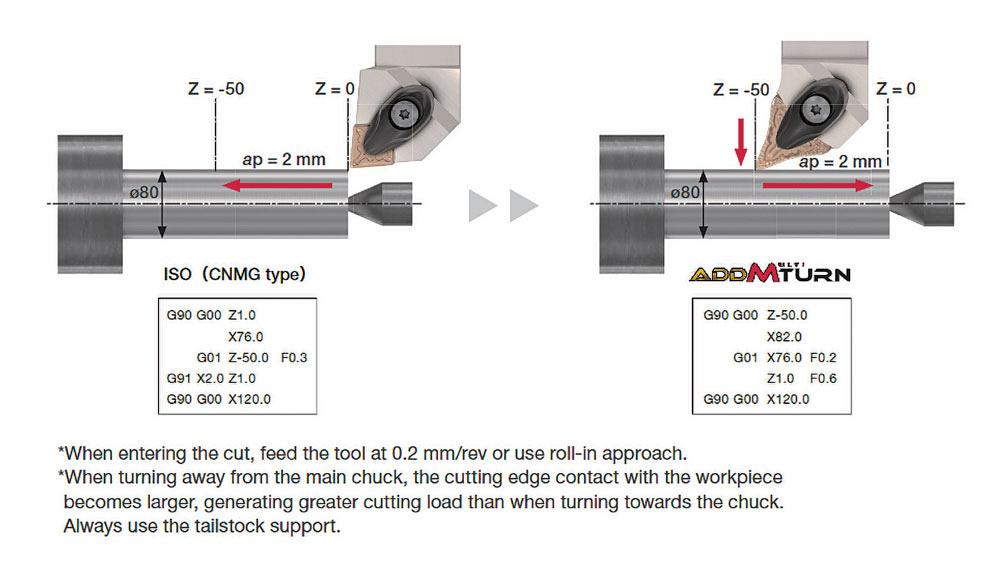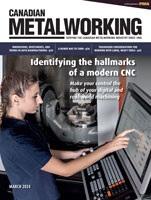Editor
- FMA
- The Fabricator
- FABTECH
- Canadian Metalworking
A newer way to turn
Multidirectional turning increases material removal rate, reduces tool changes
- By Joe Thompson
- April 10, 2024
- Article
- Cutting Tools

Sandvik Coromant’s B-type inserts are double-sided negative inserts with four cutting edges (eight total edges) designed for roughing and finishing. Sandvik Coromant
Increasing your material removal rate. Reducing the number of tool changes. Lowering cycle times. Creating a 90-degree shoulder. Profiling and facing with one tool. Roughing and finishing with one tool. Does any of this sound good to you?
Multidirectional turning tools (a.k.a. all-directional tools) have been around for a few years now. As more tooling suppliers enter the space, it’s important to get an understanding of how these tools can help you turn parts better. And it all starts where the carbide meets the metal.
Multidirectional turning tools can work in both directions (away from and toward the chuck) and perform roughing and finishing (with the top and bottom of the insert) with a single tool. They also perform multiple turning operations like profiling and facing.
This leads to both better machine utilization, because fewer tool changes are needed, and faster cycle times. It starts with the tool itself and is aided by advanced programming, unique insert geometry, and machine movement.
“All-directional turning is not necessarily new, but the tools that we would customarily use for all-directional turning were round inserts or neutral-handed inserts, and you can’t create square corners with those shapes. The newer inserts may look similar to ISO inserts in some regard, but geometries and technologies are put in place for chip breaking,” explained Keith Brake, regional product manager, turning - Americas for Sandvik Coromant. “For the multidirectional process to work, with chip control in mind, they are now their own specific shape, at least for Sandvik Coromant.”
Sandvik Coromant’s multidirectional platform, CoroTurn Prime, is more than just a tool and insert. CoroTurn Prime comprises specific tooling and software that allow for higher material removal rates, longer tool life, and better machine utilization, according to the company. CoroTurn Prime is a family of multidirectional turning tools that have a combination of small entering angles and over and under coolant capability. Currently, the company offers two types of CoroTurn Prime tools: A-type and B-type inserts. A-type inserts have three corners designed for light roughing, finishing, and profiling. B-type inserts are double-sided negative inserts with four cutting edges (eight total edges) designed for roughing and finishing.
Both inserts create thin, wide chips, which spread the load away from the nose radius. This results in increased tool life or allows for increasing the cutting data.
However, it’s as much a methodology as it is a tool.
Think of Sandvik Coromant’s multidirectional turning as the complete package; a system developed to consolidate insert inventory, enhance productivity, and improve tool life while using unique software.
When used properly, it can perform both roughing and finishing applications without changing the tool. This feature helps to reduce carbide usage and conserves turret real estate.

Multidirectional tool can perform roughing and finishing. Because there are two separate cutting edges, tool life of the entire tool is high. Tungaloy Canada
“Our second generation of CoroTurn Prime is a true eight-edged system. So, if it's properly programmed and properly implemented, you can use the chip thinning side or the high-efficiency side for your roughing application, and then you can turn right around with the same tool and you can use the other side for finishing operations without ever making a tool change,” said Brake.
CoroPlus Tool Path is a cloud-based software that can be purchased by annual subscription. This software allows feature-based programming of CoroTurn Prime tooling. Other systems capable of creating similar code for CoroTurn Prime tools include Gibbscam, Mastercam, Siemens NX, CamWorks, and TopSolid.
“We do understand that most people have already made an investment in a large CAM package, and that’s why Sandvik Coromant has partnered with CAM providers to program CoroTurn Prime inside of their systems,” said Brake.
The system can perform traditional facing and turning paths, like a CNMG 432 insert (end forward and side forward turning). Additionally, it can also perform side backward or face backward turning when engaged on the high productivity or chip thinning side.
According to Brake, roughing cycle times can be reduced by as much as 30 per cent with proper implementation of the CoroTurn Prime tooling and methodology. This is achieved with the higher productivity that the high feed side is capable of.
“For example, a CNMG 120408 may commonly run a 3 mm depth of cut in the range of 0.4 mm per revolution (MPR) feed rate whereas the Prime B insert has the capability of reaching 0.75 to 0.95 MPR feed rate at that same depth of cut. Of course, horsepower and quality of setup play a very large role in the overall success of the application,” said Brake. “It’s a combination of the way the program is created to properly enter the workpiece, and the way the inserts are designed. It’s just physics. We are leveraging physics to thin the chip with a shallow entering angle.”
It’s easy to wrap your head around the fact that cubic inches of material removed per hour is the gold standard of metrics. However, many other factors play a role in the success of a machine operation. Some of them will contribute more than others, but they all help. These tools can stack benefits.
“Because you can use the same insert to rough and finish, you can free up a slot in the turret for another turning tool,” Brake.
While this may not seem like a game-changer, every little bit helps.
Multidirectional tools are an obvious fit for complex turning applications that require multiple kinds of turning operations to be performed. However, that’s not all they are good for.

Multidirectional tooling improves machine utilization, because fewer tool changes are needed, and enables faster cycle times. Tungaloy Canada
“If you’re currently running a CNMG insert with 3-mm depth of cut or less, you can use this system in an existing program. Nothing has to change, and you can get the benefit of chip control that these insert geometries offer,” said Brake. “This can be very important for customers who are running P1 or long-chipping steel. It’s a really simple way to gain chip control if properly applied.”
Augment Existing Programs
Another option for multidirectional tooling is purchasing the tool and augmenting your G-code program.
“Multidirectional tools can be implemented easily,” said Hartej Gill, product manager for Tungaloy Canada. “We give manufacturers a piece of code with the special program required.”
The advice from Gill is to roll-in to the workpiece when entering the cut and feed the tool at 0.008 in. per revolution (IPR). When turning away from the main chuck, the cutting edge’s contact with the workpiece becomes larger, generating a pull greater cutting force, as compared to a push force when turning towards the chuck. He also advises that tailstock support should be used.
“With multidirectional tools, the common function is to perform both back turning (roughing) and front turning (finishing),” said Gill.
Tungaloy has two tools in this space, if you don’t include its multidirectional Y-axis insert. One mimics a traditional CNMG insert, and one mimics a VNMG insert for undercuts and profiles.
The tool families of 6C-TOMG and 6V-TOMG are double-sided, six-corner inserts with 80-degree or 35-degree corner angles. For pull turning, they can be used at high feeds to improve productivity by roughly 200 per cent when compared to traditional turning ISO tools. The same tool also performs push turning using the same cutting edge angle as standard ISO tools.
Another option is the 3C-TCMT, a single-sided, three-corner insert. It also enables higher feeds during pull turning when compared to ISO tools and also performs push turning.
“This insert, although it's a triangular-shape insert, has 12 cutting edges instead of six that you would expect from a TNMG-style insert because you can cut from each side of each cutting edge,” said Gill. “When you are push turning and pull turning, you're using different sides of the insert, effectively increasing tool life.”
So that is one difference from a regular insert. The other difference is the ability of these tools to perform high-feed pull turning. The insert is inclined, and, at the same DOC, the chip is wider and thinner, which allows for a faster feed to be used.
“The front of the insert is like a regular CNMG insert with 80-degree angle and five degrees of clearance. It behaves like a regular CNMG insert because it has the same shape as that type of insert,” said Gill.
Inventory Control
Each multidirectional tool can perform roughing and finishing. Because there are two separate cutting edges, tool life of the entire tool is high.
“It should maybe be thought about as two different tools, one to rough and one to finish,” said Gill. “In this case, you're using this backside as a roughing edge and the frontside as a finishing edge. This reduces the number of tools you need.”
This leads to fewer tools needed in the turret but also fewer tools needed in your tool crib. The multifunctional nature of these tools also eliminates tool changes, so cycle time is affected as well.
“The other major difference is that this insert is held differently,” said Gill. “This insert is held by a top clamp, but it also includes a rail design. When you are cutting at a higher feed rate, you now have much more effective clamping.”
This rail design, called Y-PRISM, has a rail on the shim/toolholder and matching slot on the insert for tight interlocking and secure clamping. It helps prevent cutting forces from affecting the tool position in any direction and ensures high stability.
Editor Joe Thompson can be reached at jthompson@fmamfg.org.
Sandvik Coromant, www.sandvik.coromant.com
Tungaloy Canada, tungaloy.com/ca
About the Author

Joe Thompson
416-1154 Warden Avenue
Toronto, M1R 0A1 Canada
905-315-8226
Joe Thompson has been covering the Canadian manufacturing sector for more than two decades. He is responsible for the day-to-day editorial direction of the magazine, providing a uniquely Canadian look at the world of metal manufacturing.
An award-winning writer and graduate of the Sheridan College journalism program, he has published articles worldwide in a variety of industries, including manufacturing, pharmaceutical, medical, infrastructure, and entertainment.
Related Companies
subscribe now


Keep up to date with the latest news, events, and technology for all things metal from our pair of monthly magazines written specifically for Canadian manufacturers!
Start Your Free Subscription- Trending Articles
Automating additive manufacturing

Sustainability Analyzer Tool helps users measure and reduce carbon footprint

CTMA launches another round of Career-Ready program

Sandvik Coromant hosts workforce development event empowering young women in manufacturing

GF Machining Solutions names managing director and head of market region North and Central Americas

- Industry Events
MME Winnipeg
- April 30, 2024
- Winnipeg, ON Canada
CTMA Economic Uncertainty: Helping You Navigate Windsor Seminar
- April 30, 2024
- Windsor, ON Canada
CTMA Economic Uncertainty: Helping You Navigate Kitchener Seminar
- May 2, 2024
- Kitchener, ON Canada
Automate 2024
- May 6 - 9, 2024
- Chicago, IL
ANCA Open House
- May 7 - 8, 2024
- Wixom, MI















